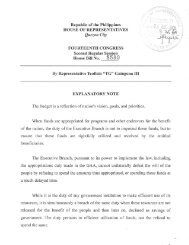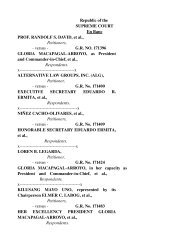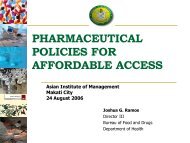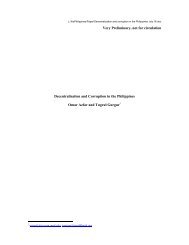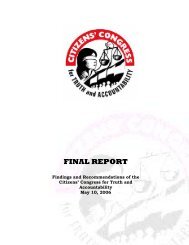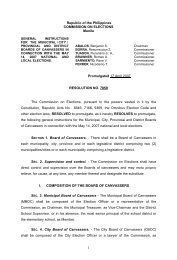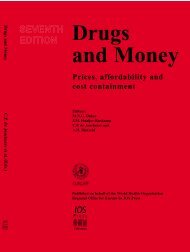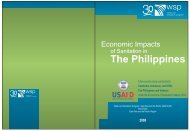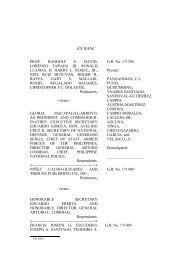i Report Issue No. 3 2005 - Philippine Center for Investigative ...
i Report Issue No. 3 2005 - Philippine Center for Investigative ...
i Report Issue No. 3 2005 - Philippine Center for Investigative ...
You also want an ePaper? Increase the reach of your titles
YUMPU automatically turns print PDFs into web optimized ePapers that Google loves.
T H E L O S T G E N E R A T I O N<br />
KB was meant to counter the<br />
growing popularity of the Left<br />
among the youth but soon<br />
became a tool to perpetuate<br />
the Marcos regime and deprive<br />
his enemies of recruits. But<br />
those who created the SK years<br />
later apparently saw something<br />
in the KB structure that made<br />
them appropriate it <strong>for</strong> the<br />
new youth organization. That<br />
wasn’t what made it open to<br />
corruption, though. Rather,<br />
it was the new components<br />
that exposed the Sangguniang<br />
Kabataan to the possible penetration<br />
of trapo<br />
ways.<br />
IT TOOK<br />
six years after the fall<br />
of Marcos be<strong>for</strong>e the KB was<br />
revived under a new name, the<br />
Sangguniang Kabataan, and<br />
only after the creation of the<br />
Local Government Code made<br />
such a resurrection possible.<br />
Like in the case of the KB,<br />
the law allowed the elected<br />
SK chair in each barangay to<br />
sit as an ex-officio member<br />
of the council, af<strong>for</strong>ding him<br />
or her the power to legislate.<br />
The same would follow <strong>for</strong> the<br />
elected SK federation president<br />
in a town or city (as councilor)<br />
and in a province (as board<br />
member).<br />
This one seat, which meant<br />
one vote, made the young<br />
ex-officio lawmakers “potent<br />
conduits of power.” But there<br />
was more: under the new law,<br />
the SK heads would receive<br />
regular compensation and allowances.<br />
And at the barangay<br />
level, the SK representative<br />
would have the discretion on<br />
how to spend the organization’s<br />
10-percent share from<br />
the general fund <strong>for</strong> youth-related<br />
projects and programs.<br />
That discretion has since<br />
been abused. Just this summer,<br />
in a barangay in an eastern<br />
Metro Manila city, a local<br />
DEVOURED BY THE SYSTEM. Young<br />
people vote <strong>for</strong> representatives to<br />
the Sangguniang Kabataan, which<br />
has fallen into the grip of corruption<br />
and traditional politics.<br />
official says the SK spent its<br />
P2.2-million budget in a barangay-wide<br />
sportsfest that cost<br />
them P1 million in uni<strong>for</strong>ms<br />
alone and P500,000 in referee’s<br />
fees. The barangay captain and<br />
the SK chair, he says, wanted<br />
such an elaborate event that<br />
they paid <strong>for</strong> the uni<strong>for</strong>ms of<br />
over 2,000 players and even of<br />
the cheerleading competition<br />
contestants.<br />
A supplier says he sold<br />
each basketball uni<strong>for</strong>m to<br />
the barangay <strong>for</strong> P450 even if<br />
he could have settled ordinarily<br />
<strong>for</strong> P350. He says he had<br />
to factor in the cut of the SK<br />
chair and the whole barangay<br />
council. “In each project in<br />
this barangay, whether the<br />
money came from the SK fund<br />
or not, the whole council gets<br />
its share,” says the supplier.<br />
“So if it’s worth P100,000, they<br />
divide the P10,000 among<br />
themselves.”<br />
Another supplier, who has<br />
sold sports and office equipment<br />
to the six barangays of the<br />
same city, says SK officials have<br />
been receiving kickbacks from<br />
projects since she began doing<br />
business there in 1999. The cuts<br />
start at 10 percent; not one SK<br />
official has turned down his or<br />
her share in all six barangays,<br />
says the supplier. One particular<br />
SK chair—a 19-year-old—has<br />
even gained notoriety <strong>for</strong><br />
demanding SOPs in advance.<br />
Says the supplier: “We give it<br />
after the barangay has paid<br />
us, not be<strong>for</strong>e. Pero makapal<br />
talaga mukha nito (But this one<br />
is really something else). Yet<br />
since we also want to continue<br />
doing business with them, we<br />
have to do what they want.”<br />
The supplier adds that the share<br />
in SOPs had even caused a<br />
dispute in the SK council; apparently,<br />
the chair had not been<br />
giving the other members their<br />
own share.<br />
Overall, the amounts<br />
involved are staggering. This<br />
year alone, P2.9 billion went to<br />
SK funds, representing 10 percent<br />
of the total Internal Revenue<br />
Allotment (IRA) distributed<br />
among the 41,885 barangays<br />
across the country. With SOPs<br />
said to range from 10 to 20<br />
percent, a total of P290 million<br />
to P580 million could be ending<br />
up as mere grease money<br />
<strong>for</strong> young politicos throughout<br />
the country.<br />
That’s the big picture. Yet<br />
even the amount of money<br />
entrusted to each SK is nothing<br />
to scoff at. Aside from its percentage<br />
from a barangay’s IRA, an<br />
SK’s money pot also includes the<br />
group’s share of the taxes and<br />
dues collected in a barangay.<br />
In rich and commercial areas in<br />
Metro Manila, an SK’s annual<br />
budget could even run into several<br />
million pesos. (See Table 1)<br />
BECAUSE OF the large<br />
amounts of money allocated to<br />
the SK, debates have broken<br />
out over how the fund should<br />
be handled. Some have argued<br />
that an SK should be guided by<br />
other officials in the barangay.<br />
That is assuming, however,<br />
that these officials are wise and<br />
beyond reproach.<br />
That certainly couldn’t<br />
be said about the barangay<br />
captain that Carlo (not his<br />
real name) found himself up<br />
against in 2002, when he was<br />
PHILIPPINE CENTER FOR INVESTIGATIVE JOURNALISM<br />
I REPORT<br />
37



